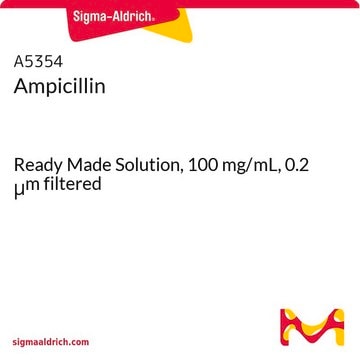About This Item
Código UNSPSC:
12171500
NACRES:
NA.56
Produtos recomendados
Condições de expedição
dry ice
temperatura de armazenamento
−20°C
Descrição geral
The pBICEP-CMV-3 bicistronic expression vector is a 5.3 kb derivative of pCMV5 used for transient or stable co-expression of an N-terminal 1´ FLAGÒ fusion protein and a selection gene in mammalian cells.
Aplicação
For transient, cytoplasmic expression of an N-terminal FLAG® fusion and a second gene of interest or selection marker from bicistronic mRNA. Two genes can be cloned into MCS1 and MCS2 for transcription of a single message from the CMV promoter. This vector is useful for protein-protein interaction studies, multi-subunit proteins, and cloning a selection marker of choice.
Ações bioquímicas/fisiológicas
The presence of two multiple cloning sites not only allows the user to clone a target gene, but a selectable marker of their choice, as well. The promoter-regulatory region of the human cytomegalovirus immediate early promoter drives transcription of the FLAG-fusion construct along with a downstream selection gene. The EMCV IRES region controls translation of the selection gene by recruiting the ribosomal subunits for cap-independent translational initiation. Depending on the mode of selection, stable transfectants can be generated by transfection using the appropriate ESCORTä product line specific for the cell type.
Outras notas
Browse additional application references in our FLAG® Literature portal.
Informações legais
FLAG is a registered trademark of Merck KGaA, Darmstadt, Germany
pBICEP-CMV is a trademark of Sigma-Aldrich Co. LLC
produto relacionado
Código de classe de armazenamento
10 - Combustible liquids
Classe de risco de água (WGK)
WGK 3
Ponto de fulgor (°F)
Not applicable
Ponto de fulgor (°C)
Not applicable
Equipamento de proteção individual
Eyeshields, Gloves
Certificados de análise (COA)
Busque Certificados de análise (COA) digitando o Número do Lote do produto. Os números de lote e remessa podem ser encontrados no rótulo de um produto após a palavra “Lot” ou “Batch”.
Já possui este produto?
Encontre a documentação dos produtos que você adquiriu recentemente na biblioteca de documentos.
R J Jackson et al.
Trends in biochemical sciences, 15(12), 477-483 (1990-12-01)
The initiation of translation of picornaviral RNAs takes place by an unusual mechanism whereby ribosomes bind directly to an internal site rather than scan the RNA from the 5'-end. This internal entry mechanism requires a 450-nucleotide segment of the picornavirus
P L Hallauer et al.
BMC genetics, 1, 1-1 (2000-10-19)
Versatile transgenic manipulation of skeletal muscle requires knowledge of the expression profiles of diverse promoter/enhancer elements in the transcriptionally specialized fiber types of which muscle is composed. "Universal" viral promoters/enhancers, e.g., cytomegalovirus IE1 (CMV IE1), are of interest as reagents
S K Jang et al.
Journal of virology, 62(8), 2636-2643 (1988-08-01)
Picornavirus RNAs are uncapped messengers and have unusually long 5' nontranslated regions (5'NTRs) which contain many noninitiating AUG triplets. The translational efficiency of different picornavirus RNAs varies between different cell-free extracts and even in the same extract, such as micrococcal
S Andersson et al.
The Journal of biological chemistry, 264(14), 8222-8229 (1989-05-15)
The conversion of cholesterol into bile acids in the liver represents the major catabolic pathway for the removal of cholesterol from the body. In this complex biosynthetic pathway, at least 10 enzymes modify both the ring structure and side chain
D R Thomsen et al.
Proceedings of the National Academy of Sciences of the United States of America, 81(3), 659-663 (1984-02-01)
The DNA templates containing immediate early (IE) genes of human cytomegalovirus (CMV) were transcribed in vitro by using a HeLa cell extract. When IE region 1, 2, and 3 were used, transcription was detected qualitatively only from IE region 1.
Nossa equipe de cientistas tem experiência em todas as áreas de pesquisa, incluindo Life Sciences, ciência de materiais, síntese química, cromatografia, química analítica e muitas outras.
Entre em contato com a assistência técnica







